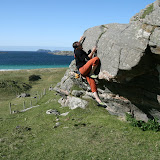
It had not rained in the Hebrides for over six weeks, significantly anyway, a light shower during the night to dampen the corncrakes' dry rasps, I was told. The heather was crispy, the sphagnum like large green trampolines. The lochs all had a dry skirting board of whitened rocks and cracking peat bogs and sand was beginning to cover everything, covering some of the roads in a futuristic apocalypse of blown sand!
I took a full week to explore some of the Hebrides fine Lewisian Gneiss and wasn't disappointed, adding a good blue circuit to the problems around the crag at Traigh na Berigh. I'll put a full topo up on www.stonecountry.co.uk but here are some more pics on my Picasa site.
 |
| Lewis Bouldering |
Sron Ulladale was most impressive and bone dry, though I saw no climbing parties about... amongst the giant boulders at the bottom I spooked a big cat (either that or a fox) and discovered a pair of green wellies and a frying pan if anyone wants them back? A particularly good swim is the 'jacuzzi pool' flowing out from the Waterboard dam on the walk-in... just beware sweeping vortex currents, I went round and round like a drowned fly in champagne until I could grab a rock to haul myself out spluttering and chastised of my boldness.
I'll post some bouldering news shortly, as well as sample pages of some of the new books in production at Stone Country... the new Font guide will be here soon!